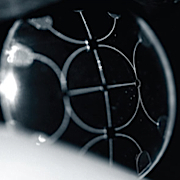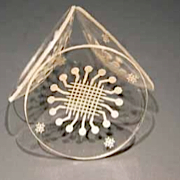Focus on the future: the Bionic lens

Even though I’m nearsighted I don’t see myself wearing contact lenses in the near future. It’s a love-hate relationship. I hate them because they irritate my eyes and yes, I’ve tried them for several years. So I wear glasses but would love to be able to wear contact lenses. Not so much because a choice of shades would be nice but but because of what the future of contact lenses may hold in store for us. Let’s take a brief look at what the labrats are working on.
Bionic contact lens

When? Just wait and see...
Scientists at University of Washington have been working on a prototype bionic contact lens that could display information in the form of augmented reality beamed from a mobile device for some time now. Recently this research was in the news again because they solved the problems of powering the electronic circuitry of the bionic lens. The circuitry’s 330 microwatts doesn’t need battery. Instead it harvests power from radio waves, beamed, for example, from a mobile phone. The radio waves are picked up by a tiny loop antenna in the contact lens. Later this month the team of scientists will present their prototype at the BioCas 2009 conference in Beijing.
Tracking eye movement
In 2007 scientist developed a method to make magnetic contact lenses that allow for sophisticated eye movement tracking. Most systems use a camera to follow your pupils and image recognition software to figure out what you are looking at. These systems are limited. You can only use them in a set environment such as behind your computer or in a cockpit of a jet fighter. If you face away from the camera the system will not work and if, like me, you wear glasses the software gets confused. The magnetic contacts however, could work anywhere you go. A sensitive magnetic sensor attached to your head can detect minute changes in the local magnetic field when you move your eyes. Add a digital compass and it doesn’t matter if you twirl your body around 360 degrees. The system knows what you’re gazing at.
Health monitoring lenses

What's up Doc?
Another group of scientist made a contact lens with a built-in pressure sensor. It monitors eye conditions such as glaucoma. Eyes can tell a great deal about a person’s health including early signs of heart disease. All sorts of sensors could be built into contact lenses that could monitor your health and give you early warning signs something’s about to go haywire in your body.
Self-shading contact lenses
The Institute for Bioengineering and Nanotechnology (IBN) in Singapore developed the first ever transition contacts. Regular transition glasses that darken when exposed to bright light have been around for many years. A coating of photochromic dyes change shape when hit by sunlight and the dye particles become like ‘shutters’ darkening the lenses, partially blocking the sunlight. However, the nature of the soft contact lens material makes it impossible to evenly coat them. The IBN scientists found away to embed the dye in the lenses with nano technology. It turns out that these transition contact lenses darken much more rapidly than normal transition glasses. Could this mean the end of sunglasses?
Unprecedented augmented reality

Forever and ever...
I doubt it. Not only are shades cool but there’s also room for both future smart shades and bionic contact lenses. Combine the above mentioned examples and what do you get? A health monitoring, bionic contact lens that offers you an unprecedented augmented reality experience. But before such smart contact lenses will see the light of the day this type of future display technology will first be implemented in ‘regular’ glasses. Next year Brother will bring the Retinal Imaging Display (RID) glasses that augment regular vision on the market. There are plenty more examples of virtual reality glasses with built-in displays.
Smart shades
But even when all this technology finds its way into contact lenses, smart shades could still complement the bionic contact lens. First of all not everyone can wear contacts and smart glasses with the same capabilities as the bionic lens could be the solution. Of course, future nano or biotech technology will probably improve contact lens materials to such degree that irritation will be minimal or even non-existent but lets skip that for the moment.
The first generation bionic lens will need something like smart shades. Glasses or shades could house the magnetic sensor together with a gps, a radiowave power source, a digital compass, earphones and a wireless connection to your mobile phone that will do all the processing. The LCD glasses could also ‘pull the shades’ so you could watch a movie in ‘darkened room’ while sitting in the train, bus or an airplane. Most likely, the bionic contact lenses will be able to do that to at some stage.
To be or not be… cool

Babe! Please? How about shades?
But still, most likely we’d wear shades in the beginning. What is all that tech in bionic contact lenses going to look like? Will we have the look of a zombie with a thousand mile tech stare? Will our eyes look like we’re all suffering from hi-tech cataracts? Shades will be the answer for the time being.
Science and technology will find a way to make the hardware in your bionic contacts transparent or at minimum display a virtual dynamic video image on the outside of the lens so you eyes may look normal to other people. We won’t need transition materials in our lenses either. The bionic contact lens will smart shade electronically and instead of shades we’ll all probably all wear a tiny stud in our ears that contains all the hard and software, at least for awhile…
Comments
One Response to “Focus on the future: the Bionic lens”
Leave a Reply





Oahu is the ideal time to make a several plans money in fact it is time to be at liberty telefoon hoesjes. I’ve truly master this article of course, if I may I want to suggest you actually several interesting issues and also information. Perhaps you might publish subsequent content articles making reference to this information. I want to continue reading reasons for having them!